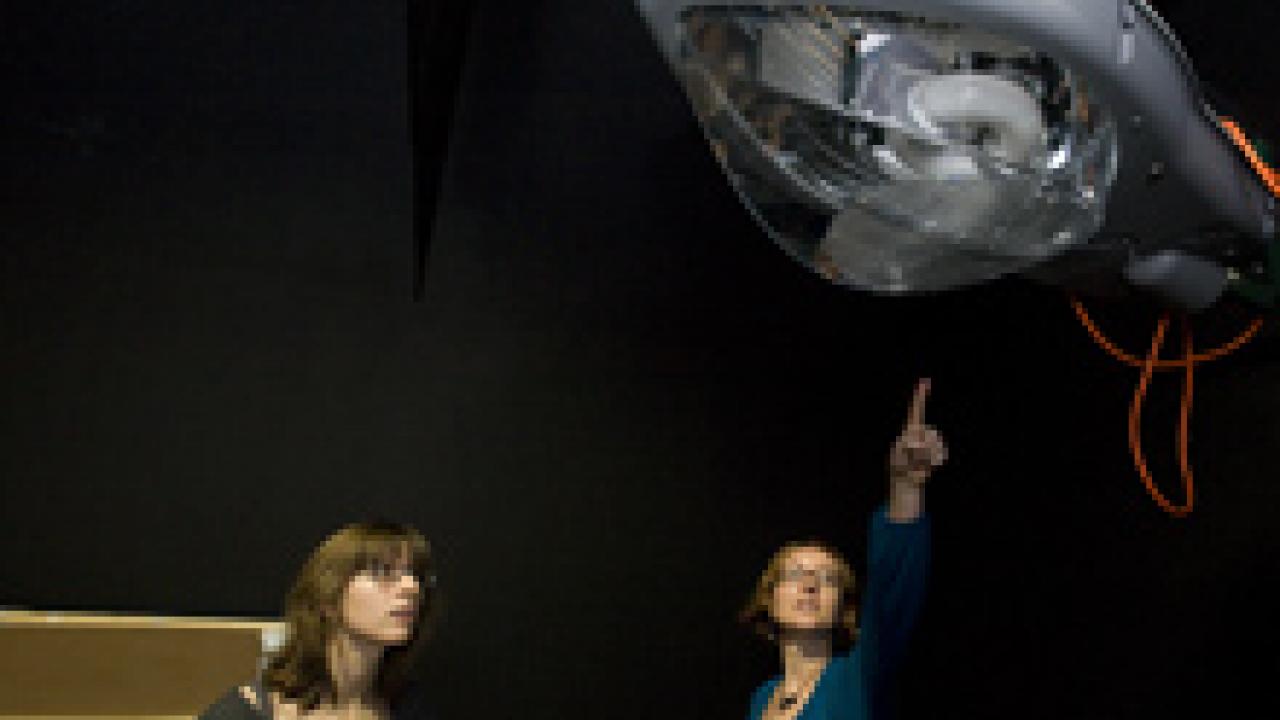At just five years old, the California Lighting Technology Center at UC Davis has so many successful projects under way that it has moved into a new facility with twice the space.
On Jan. 20, the center hosted an open house to show off the energy-saving lighting systems ready now or coming soon for homes, offices, businesses, and even parking lots.
“Energy-efficient lighting has never been more important or more achievable,” said center director Michael Siminovitch, a professor in the UC Davis Design Program. “We have innovative products for every lighting need that can cut electricity use by up to 50 percent, which saves consumers money while helping the environment.”
The move into the new, 14,000-square-foot facility gives the center more room for demonstrating new products, as well as education, training and research.
“Education continues to be at the core of our mission,” said Siminovitch. “New lighting and lighting-control technologies will save energy only after they are installed. The next generation of lighting designers, architects, contractors and facility managers need to know about them to make that happen.
Some of the new products on view or in development at the center include:
Offices: Energy-efficient systems focus light on the task at hand, automatically respond to available daylight, report energy use to the larger office community through Web-based energy-monitoring software, all of which reduce energy use;
Classrooms: Designed with teachers in mind, the Integrated Classroom Lighting System improves classroom light quality while reducing energy consumption and features occupancy sensors that turn off lights in empty rooms. The lighting center is also working on energy-saving retrofits that will let schools improve upon the common practice of replacing aging T-12 fluorescent light fixtures with more efficient T-8s.
Kitchens: There are 800 million downlights in use in the United States, and they are a design staple in kitchens. The California Lighting Technology Center is demonstrating the benefits of LED downlights that are dimmable and come in a range of color temperatures as well as a variety of traditional and contemporary designs. Currently on the market, and on view in the lighting center LED Kitchen, are the Cree LR-6, Progress EverLume and the Cooper Halo. With an average input power of 10-12 watts, these downlights save more than 75 percent over incandescent lights.
The lighting center also is showcasing a next-generation product prototype that shines light up into the can fixture and then down into the room. Up to 10 of these downlights can be linked to one wall switch on low-voltage cable. Installation with this system requires less labor than the traditional housings. The lights are called Lighting California’s Future Advanced LED Downlights.
Home living areas: The center demonstrates LED lighting for the home that takes advantage of the intense bright light offered by LEDs but tempers it for use in a ceiling fan, wall sconce or bathroom vanity. Four next-generation prototypes are on display in a model living room sponsored by Progress Lighting.
Stairwells: Bi-level stairwell lighting gets bright when people are on the stairs, and then dims when they’re gone. Modernizing this often-overlooked area can reduce annual stairwell energy use by 40 percent to 80 percent.
Warehouses and big-box stores: Smart high-intensity-discharge (HID) lighting is both dimmable and controllable. Daylighting sensors for skylights can automatically dim electric lights when there is enough daylight.
Parking lots and garages: Lights with motion sensors use half the energy of conventional lights when the space is unoccupied but provide greater safety, while reducing light pollution and waste. The California Lighting Technology Center is showcasing the diversity of lighting options for exterior use, including systems that use LED, induction, plasma and hybrid light fixtures with bi-level capabilities.
Streetlights: One product, the BetaLED “Edge” series, reduces light pollution spilling into homes by focusing the light onto the street and sidewalk.
The California Lighting Technology Center at UC Davis was established in 2004 with funding from the university and the California Energy Commission’s Public Interest Energy Research Program, with additional support from the U.S. Department of Energy and the National Electrical Manufacturers Association.
The center’s key missions are to increase the use of energy-efficient lighting (including daylight) through collaborations with energy utilities, lighting manufacturers, end users, builders, designers, and government agencies; and to educate the next generation of lighting engineers and designers.
Today the center has total funding of about $2.5 million per year from utilities, government agencies and the university. The center also boasts an affiliate partnership program with more than 50 manufacturers and large end-users. It has more than 30 employees, including professors, full-time staff members, graduate-student researchers and student interns.
In recent weeks, the center received three major new grants:
• $5 million from the U.S. Department of Labor to the center and the National Electrical Contractors Association for training on advanced lighting systems controls;
• $3.2 million from the California Energy Commission for lighting research; and
• $2 million, also from the California Energy Commission, for commercial lighting retrofits in collaboration with the Energy Efficiency Center and the Western Cooling Efficiency Center, both at UC Davis.
The open house included opening remarks from UC Davis leaders and a delegate from the California Energy Commission, followed by tours and demonstrations. To watch a slideshow of the event, go to www.news.ucdavis.edu, and click on the lighting center open house news release.
Media Resources
Clifton B. Parker, Dateline, (530) 752-1932, cparker@ucdavis.edu
